 |
|||||||||
Classical Editor: Rob Barnett
Music Webmaster
Len Mullenger:
Len@musicweb-international.com
|
Classical Editor: Rob Barnett
|
||||||||||||||||||||||||||||||||||||||||||||
|
|
April 1999 |
|
|
|
||
© Music on the Web(UK) 1999. All rights retained. Reviewers retain copyright on their reviews. Disclaimer
![]() COMPETITION WIN
a CD of your Choice from Crotchet
COMPETITION WIN
a CD of your Choice from Crotchet
![]()
RAUTAVAARA, Einojuhani. Cantus Arcticus, Op 61 (Concerto for Birds and Orchestra); Piano Concerto No 1, Op 45; Symphony No 3, Op 20. Laura Mikkola (piano), Royal Scottish National Orchestra, Hannu Lintu.
DDD [73' 32"]. Naxos 8.554147.
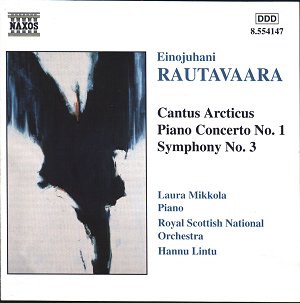
What a splendid disc ... and what a bargain! Congratulations Naxos and you have contributed to this reviewer's profoundest satisfaction.
The Piano Concerto No 1 has always been a very great work as far as I am concerned. It has all the ingredients of being a masterpiece. It is original and not a copy of anything that has gone before and this is the vital essential of a great composer. It has durability. I can listen to it again and again and never tire of it. The composer's skill, technique and orchestration is exemplary; it is music of worth; it has something to say and says it; it has contrast ... on the one hand, powerful drama and excitement and, on the other, a tender lyricism. It has wonderful, unpredictable harmonies at times and yet has some conventional features as well. It has the quality that almost everyone wants in a piano concerto; that stunning virtuosity that brings the house down. Of course, there are idiosyncrasies but then it could be argued that, for example, baroque composers has such formulae with their ornamentation and other features. The big, broad melodies of the Rautavaara are post-Rachmaninov but without the mawkish sentimentality and with the advantages of big harmonies. Soaring violin melodies in the second movement are supported by some astonishing harmonies and some warmth in the strings. Not everyone will like the palm clusters or the forearm clusters but aren't they exciting and dramatic? The finale is molto allegro that is too short! It contains some glorious surprises!
The Symphony No 3 precedes the Concerto by about ten years being completed in 1960. It is a fascinating contradiction of something both tonal and dodecaphonic although not strictly so. The music conjures up an impressive visual imagery through a wonderful tapestry of sound from the desolate to the majestic. There is humour, playfulness and opulence; there is grandeur and solemnity and four Wagner tubas. It has a rather loose structure as can be noted in the Symphony No 4 of Jean Sibelius. It yields its rewards and its treasure by listening to it. Real music is not entertainment or a background; it is to be an all-embracing experience.
The Cantus Arcticus may be Rautavaara's most famous piece. The bird song was taped in the Arctic Circle. This sound world is unique and totally absorbing. When a composer can successfully produce a pictorial realisation in an aural treatise he has made a great achievement. The cold and the migrating swans are captured with great imagination and the use of aleatoric passages is relevant in this rather special piece. It is both evocative and communicative and has a documentary feel.
Wildlife on One? No, I prefer Rautavaara's Opus 61.
The performances are very good. Laura Mikkola is a gifted pianist who has many famous teachers to her credit and who has worked with first-rank conductors. There is a strength in her playing and for this concerto she needs it. Hannu Lintu is a conductor that we should hear more of and the Royal Scottish National Orchestra reveal that they are a fine ensemble who benefitted enormously from the work they did with Bryden Thomson. The sleeve note contains one glaring error but you will have to buy this bargain CD to resolve it.
Reviewer
David Wright
Performances

Recording

ROUTH, FRANCIS. A Sacred Tetralogy (I - III) for organ; The Manger Throne Op 3 (1959); Lumen Christi Op 15 (1969); Aeterne Rex Altissime Op 20 (1970). Christopher Bowers-Broadbent at the organ of Coventry Cathedral.
Redcliffe Recordings. RR012. [67' 03"].
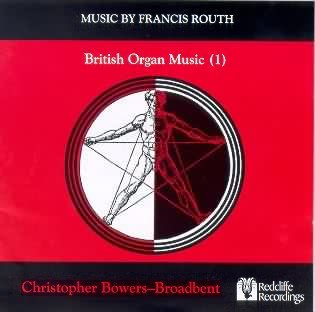
This is a splendid disc and recommended without reservation.
Let it also be said at once that Coventry's organ is magnificent and has a clarity and brilliance that is superb. Bowers-Broadbent is a virtuosic performer with secure hands and is also incredibly safe-footed. His articulation is extraordinary and his playing is always precise and clear. He is totally in control. The recording engineers have also excelled themselves.
This is most impressive music and sadly reminds us that we have a dearth of British organ music. Denis ApIvor, James Brown, Peter Racine Fricker, Priaulx Rainer, William Mathias and Humphrey Searle have all written effectively for the 'king of instruments' but in Francis Routh we have surely found the finest modern British composer of organ music. Not that it should be thought that he has only written for the organ. He has written concertos, a symphony, some amazingly fine piano music and vocal works of great distinction.
Olivier Messiaen seems to hold the monopoly of organ music of this soon-ending century. Francis's music is more absolute, is far better structured and has a welcome sense of direction and purpose. For those who 'fear' modern music let me assure you that this music is not fragmentary or abounding in clusters. Nor does it ever sound like a traffic jam but, while it has both originality and exemplary skill, it retains the certainty of traditional convention.
Each of the three works has three movements. In The Manger Throne Op 3 the central più mosso section is a rare joy of exciting music. The second movement is akin to a pastoral and uses Es ist ein 'Ros' entsprungen making the movement into a kind of chorale prelude. The finale has toccata-like qualities and introduces another carol In dulci iubile ... simply, quietly and effectively. The end is a wonderful exhilarating flourish.
The quality of the music, whether it is peaceful or triumphant, is of the highest order.
Whereas Op 3 deals with the Nativity, Lumen Christi Op 15 deals with Easter and the representations of light and darkness. The opening movement with its effective use of chromaticism and rising fourths gives it a clear shape. The central Agnus Dei is music that unfolds a beautiful melodic line in which the softer tones of the organ are shown to great advantage as it is in the quieter sections of the final Allegro vivace. It heads towards a brilliant climax with the theme in fourths on the pedals. The final flourish is a statement of resurrection, rather than a showy conclusion.
Aeterne Rex Altissime Op 20 is a more austere work and is based on a plainchant. There is a well-judged contrast between simple melody and controlled outbursts of rich sound. The first movement ends with an amazing study in counterpoint with flowing semi-quavers leading to a chordal conclusion. The slow movement is often very beautiful and communicates its material instantly as all great music should. The finale begins Andante and ends Vivace con brio. The quiet mystery of the opening advances to a rich climax. The plainchant sings its melody and the coda represents the ascension itself: Christ in glory. It has a wonderful swagger ... and those pedals!
Indeed, this is a splendid disc recommended without reservation. A second disc of Francis's organ music is due out later this year. I can't wait!
Reviewer
David Wright
Performance

Recording

Further details of this recording, including booklet notes, are available from the Redcliffe Recording site
DMITRI SHOSTAKOVICH (1906-1975) Complete (15) Symphonies. Moscow Philharmonic Orchestra/Kyrill Kondrashin.
BMG-Melodiya 74321 19839/48-2 10 CDs
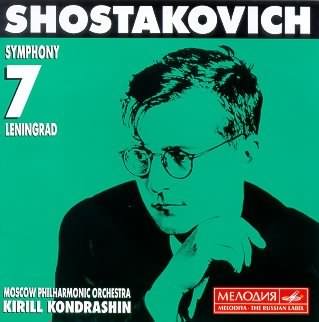
DMITRI SHOSTAKOVICH (1906-1975) Complete Symphonies.
No. 1 in F minor (1925) **
No. 2 in B, "To October" (1927) (Choirs of the Russian Republic) rec 1972
No. 3 in E flat, "The First of May" (1929) (Choirs of the Russian Republic) rec 1972
No. 4 in C minor (1935) rec 1962
No. 5 in D minor (1937) rec 1964
No. 6 in B minor (1939) rec 1967
No. 7 in C, "Leningrad" (1941) rec 1975
No. 8 in C minor (1943) rec 1961
No. 9 in E flat (1945) rec 1965
No. 10 in E minor (1953) rec 1973
No. 11 in G minor, "The Year 1905" (1957) rec 1973
No. 12 in D minor "The Year 1917" (1961) **
No. 13 in B flat minor, "Babiy Yar" (1962) (Artur Eisen, bass; Choirs of the Russian Republic) rec 1967
No. 14 (1969) (Evgenia Tselovalnik, sop; Evgeny Nesterenko, bass)
No. 15 in A (1971) rec 1974
Moscow Philharmonic Orchestra/Kyrill Kondrashin.
BMG-Melodiya 74321 19839/48-2 10 CDs
** Not heard by reviewer
These are grainy but shockingly intense performances with rather stressed recording quality to match. The recordings represent a true 'intégrale': a cycle by a single utterly involved and involving conductor and a deeply dedicated and often possessed orchestra.
One health warning. Sadly I was not able to get hold of every disc in the sequence. There are ten discs and the disc coupling symphonies 1 and 12 was not available.
The discs are not desperately well filled (in terms of playing time) but the whole set is at mid-price and by now may be being remaindered and is a significantly attractive bargain even at its usual mid-price.
Those who hanker for subtle recorded sound should opt elsewhere, perhaps for Haitink's distinguished cycle of which I confess to have heard little. However Kondrashin's way with the symphonies is overpowering and I prefer it over the smoother-edged approach even when that approach is eloquently conveyed.
Kondrashin's readings are direct and bear the authority of the composer's involvement in many of the performances. This conductor's recordings usually have a burning drive and razor-edged communication. In these qualities he is rivalled most consistently by Mravinsky who (sadly) did not record a complete Shostakovich cycle.
The present set has been issued previously by Chant du Monde in the late 1980s and previously in the moribund era of the LP by EMI (1985) on 12 black discs. Before that the occasional disc appeared as part of other cycles and in isolation. I recall that some of the Kondrashin performances were included in the 1975 complete HMV (SLS5025) LP set of the Shostakovich by a mix of USSR conductors and orchestras. This box is still in my collection. Kondrashin's recordings formed the core of the set although Maxim Shostakovich's account of 5 and 15, Barshai's 14, Mravinsky's 12 and Svetlanov's 7 and 10 took the place of other Kondrashin tapes now restored here.
As already indicated the orchestra's playing is not subtle. What it lacks in fine tone painting it gains in sheer pain, acidic expression, devastating concentration and blood coursing through the veins and arteries of the music.
The sturdy box is handsomely produced. The set is not listed in the current BMG-Melodiya catalogue but copies still seem to be available. I noticed it on the shelves of Manchester's HMV shop when I was there at the beginning of March. Notes are rather brief although the general essay about the Russian symphony (it appears in each CD's booklet is worth a read). I should clarify that there are notes on each symphony. Sadly, sung texts are absent.
The first three symphonies. The first I did not hear however Kondrashin's No. 2 is a rather rushed affair. No. 3 suffers in much the same way although both works communicate well, if in a typically driven way. I seem to recall another Melodiya set (possibly conducted by Igor Blazhkov) of these early revolutionary/modernistic symphonies.
A burning acidity hangs over the recording of the Fourth symphony. String sound is strident and the brass choir is blatant, almost acrid. But through all this (or perhaps because of it) the performance positively throbs with life. The recording is ancient in our terms, dating from 1961.
The Fifth is not so much haunted by time's wingèd chariot as hunted down in a breathless death-chase. Possession and ferocity may perhaps have gone a degree or ten more than the ideal here. However there is no denying the power of this performance. My old LP from the EMI set (as conducted by the composer's son) is more balanced but Kondrashin is unlikely to disappoint you.
Kondrashin's Leningrad in all its refinement (yes, that is the word) and flaming emotion is amongst the arterial strengths of the box. Grim and poetic qualities light up this work in a way you probably would not have expected from this conductor and especially not in this work. The long first movement is notably well done with the performance successfully conveying the remorseless steel-tracked march.
No. 8 is an old recording (circa 1961). It is a pity that the master tapes could not be 'reconstructed' as their distressed state rather shows through. Nevertheless there is no denying the sense of searing penetration and concentration communicated by conductor and orchestra. Desperately impressive.
The Ninth symphony was recorded in 1965 and sounds broader and deeper and at least a decade better than the recording of the Fourth. It is a possessed performance driving forward harder and harder. The slow movement is notable for a sense of emptiness rivalled only by Vaughan Williams' Sixth.
The Tenth is distinguished by a dashing almost gabbled scherzo. The Allegretto dances along blithely and the finale is intensified by the knockabout recording quality. It successor is most successfully conveyed by the Helsinki PO conducted on Delos by James de Preist. I write from memory and also from memory I recall an extremely impressive Berglund conducted performance on EMI (Bournemouth SO, EMI) which outpoints the Kondrashin.
I have not heard No. 12. In No. 13 Kondrashin's Artur Eisen is a tower of interpretative strength seemingly responding with sense and emotion to the words as a linked shadow and reflection of the words. Kondrashin's Thirteenth is reckoned to be the finest studio recording but there is also supposed to be a live recording on Russian Disc reputed to be well worth tracking down. Kondrashin's BMG recording communicates commitment and fury as does the bleakly expressive chorus.
Kondrashin's version of the Fourteenth is in the front rank as an interpretation and the sound is by no means as crude as you may fear or anticipate. The conductor is typically devil-may-care but this contrasts rather poignantly with Evgeny Nesterenko's way with the words. Evgenia Tselovalnik is rather less impressive than Nesterenko whose bass voice is all ebony and sepulchral gloom. The Moscow PO play their hearts out for Kondrashin: white hot dedication. The final symphony remains an enigma but a compulsive one. The parodies, infernally ticking clocks and graveyard humour … and drama are ardently articulated. Not to be missed.
In this set there is nothing of caution or routine. Instead there is a giving up to the emotional flame of Shostakovich's inspiration. As I have said before this Russian series from BMG is startlingly underestimated. I suppose that if you demand the best of Shostakovich a single box with one orchestra and conductor spanning fifteen symphonies is not the ideal way to add to your collection. The ideal would be to pick and choose carefully among the many performances out there. However if you are attracted by the convenience of a single cycle Kondrashin's has undeniably memorable musical strengths. You must accept some technical deficits but the musical rewards patently carry the day.
Reviewer
Rob Barnett
tar.gif)
Richard STRAUSS Elektra Resnik, Nilsson, Collier, Stolze, Krause, Vienna Philharmonic, Solti
remastered Decca 417 345 2 (2CDs Full price)
This is a technical appraisal of the remastering of the well established recording
Decca has recently reissued a number of analogue Solti opera recordings with the benefit of refurbished sound obtained by remastering with a 96kHz 24-bit Genex recorder and the CEDAR DH2 de-hisser. I have been able to compare the two Ring cycles and have now been listening to Elektra. I am grateful to Marjorie Williamson for lending me copies of the original CDs (complete with booklet autographed by Birgit Nilsson).
I will answer the obvious questions immediately.
Is the sound an improvement? - Yes it is. There is a small but real difference.
Should you replace your original CDs with this new issue? No there is little need, particularly as Decca have made the utterly reprehensible decision to re-release at premium price thus cutting off a large portion of their potential market..
In side by side comparison there are discernible improvements but I have to admit that this wonderful Strauss score so captivated me that I often found I had forgotten which version I was listening to. At reasonably high playback levels there is little discernible hiss on the original issue so the Cedar DH2 de-hisser did not have much de-hissing to do. Disc one of the new issue is cut at a slightly lower level than the original whilsy disc 2 is slightly louder which made the job of comparison more difficult. Your money buys you new packaging (although I have an affection for the old Salome and Elektra LP covers), the original booklet printed on better quality paper and a new booklet of photographs and including a couple of essays: Michael Kennedy on 'Strauss and Solti' and James Lock on 'Recording the Strauss operas with Solti'. It looks as if this booklet might be common to the series and from it we learn that Elektra was a four track recording using the Culshaw grid on the sound-stage, and that these four track recordings were used for this re-release but were not used for the original CD release which was developed from the stereo master tape. That is where the improvements lie.
As I have said, there is a small but real difference and improvement in the sound; my difficulty is in describing it to you. The re-issue has a more dispersed sound, both tonally and spatially, and the voices give a better impression of coming from a stage. This makes the component parts more distinct and easily discerned and the whole listening experience is a more relaxed one. The original issue opens by throwing the sound image in your face like an uncomfortable splash of cold water full of ice chunks from which you immediately recoil. The re-issue has greater depth, the bass drum and lower strings are more clearly defined and the effect Strauss wanted to achieve more easily discerned. Instead of recoiling from the sound recording you now recoil in horror from the effect Strauss produces (this is not a pretty opera)!
I always found that these Decca Solti opera issues from the 1960s had a particularly strident edge to the brass and voice - even on the original LPs. This wearing sound was very exciting - 'cutting-edge' for their time - but ultimately exhausting to listen to. The LPs actually improved after a few runs of the stylus which seemed to smooth away some of this edginess but this was retained on the original CD issue and, of course, does not get smoothed away. Nevertheless, the CD offered a much improved definition - particularly in Salome (I am not a flat-earther). The re-mastering has cleaned this edginess away. If you possess the original CDs you will hear what I mean in the searing, piercing trumpet at 0.22' of track 1. Equally the triangle is more realistically musical at 1.32'
The orchestra plays in a more three-dimensional space with a more believable depth of sound stage, try the quieter passage from 5.48' onwards. Strings and woodwind are beautifully balanced, the new distance lending enchantment, but the chugging basses at the start of track 2 still exert their powerful effect as Elektra appears before us. The buzzy, edgy halo that is a feature of Nilsson's voice has also been rendered less intrusive without any loss in the power of her projection. In the first meeting of Elektra and Klytämnestra one is again aware of a slight widening of the soundstage with increased openness, each voice has greater separation and projects with improved clarity. But again I must stress that although I am using adjectives such as 'greater', the overall change really is slight, but it is an advance and shows how good the original DECCA recordings were. We knew that, of course, from Das Rhinegold which is absolutely amazing for its age!
Orestes is Dead! I played this scene with Chrysothemis and Elektra several times because I found so little difference between the two transfers at this point. I had hoped the separation between the two voices might have been increased. In a blind testing I suspect I would find it very difficult to distinguish one transfer from another at this point, the earlier transfer being distinguished only by a slight tunnelling of the sound. When Tom Krause enters (track 6) there are one or two silent passages (rare in this opera) where the improvement in residual noise can be noticed in the re-issue and again, the slight spreading of the sound is more realistic with less 'spitting' to the treble. In the original transfer both voices become a little hectoring in the scene that follows and, to some extent, this is smoothed out in the re-issue.
Should you have the opportunity to compare these transfers my recommendation would be to try track 11 on disc 2. Here you can appreciate the solidity of the basses (never to be matched in the opera house I suspect) and the total silence surrounding them. Tape hiss audible in the original here has been completely removed.
Clearly Decca have been convinced that the sound could be improved in a new transfer. There are other recordings of this vintage which will probably show a more dramatic improvement; I am thinking of the War Requiem in particular and this is to be released soon. My recommendations are as at the head of the article. Should you have been hanging your nose over this recording as a first purchase - hesitate no longer
Reviewer
Len Mullenger
Equipment used: Aiwa XC750 CD player fed directly into a Quad 405 power amp. KEF Reference 104/2 speakers.
Richard STRAUSS (1864-1949) Macbeth; Don Juan; Tod und Verklärung Saarbrücken Radio Symphony Orchestra conducted by Günther Herbig
ARTE NOVA 74321 59232 2 [58:16] Superbudget price
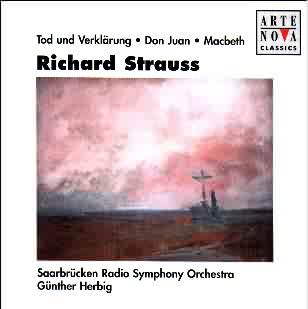
The super budget Arte Nova label is gaining a reputation for quality and originality. The focus of interest in this collection of Richard Strauss's tone is the inclusion of the earlier work, Macbeth which is something of a rarity, as far as recorded performances are concerned, in comparison to his other tone poems. Macbeth turns out to comprise much of the sort of material we meet in the other tone poems on this disc plus a little of Till Eulenspiegel; although, towards the end the atmosphere becomes appropriately doom-laden.
Herbig gives energetic performances of the better-known tone poems. His Don Juan is lusty and sensuous, as adept with his blade as he is around the petticoats and his everyman hero of Tod und Verklärung has something of the Don too before his appointment with Death. The transfiguration episode is moving and dignified. There are higher-voltaged readings of these more well known works but the recorded sound is very good and with the inclusion of Macbeth this is a firm recommendation in its price range. The documentation is sparse and inadequate
Reviewer
Ian Lace
tar.gif)
PIOTR TCHAIKOVSKY Scenes from The Nutcracker (1890) Francesca da Rimini (1876) Leningrad PO/Evgeny Mravinsky
Live recordings from 1981 and 1983 respectively. Concert Hall of the Leningrad Philharmony ICONE ICN9410-2 [59:07] Midprice
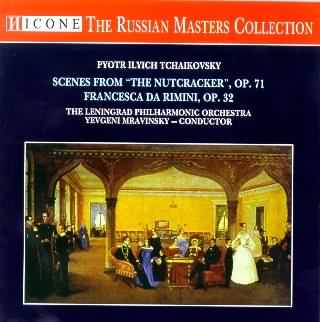
This is a rare event: a single CD of Mravinsky-conducted music at bargain price. Icone have a done a respectable job with the radio tapes from which these are taken. Presumably these are the same performances as have appeared on Philips and Olympia in years gone by and currently on BMG’s 20 CD 2 volume series. Mravinsky’s Tchaikovsky is fabled. He attained the heights with fabulous performances from the early 1960s on DGG LPs. These are still available and have been much reissued. I refer here to the stereo version although I know that the Leningrad PO and Mravinsky also had mono performances from the 1950s of Symphonies 5 and 6 and that these have been reissued on CD with a Jansons conducted Symphony No. 4.
Although playing for just short of an hour the present disc represents excellent value. What almost startles is the unanimity of attack and the consistency and colour of the sound. The concert hall ambience also helps even if this means that there is coughing during the Nutcracker excerpts. The Nutcracker is presented with every splendour as a children’s horror book full of strange pictures: fear and beauty stalking the corridors. Bogeymen are under the bed, toys come to life and a snowy romance is in the air. As for Francesca this is one of Tchaikovsky’s most undervalued scores. For anyone who has discovered the composer through Symphony No. 4 I would always recommend hearing a good performance of Francesca before referring them to Symphonies 5 and 6 or Romeo and Juliet. Interestingly I see that the composer planned an opera on Francesca but this came to nothing and it was left to Rachmaninov to produce his own impressive effort (now there is a piece that could do with reissue on CD). Mravinsky plays Francesca at full throttle.
The audience is fairly quiet as well they might be in the face of the white hot winds and passion that thresh the air and the delicate clarinet-led romance that dominates the central softer core of the work. Hearing this performance you can hear what inspired Sibelius in Tapiola and The Tempest and Bax in the grittier romance of November Woods. This is still not the equal of a 1979 BBC broadcast by the LSO conducted by Yuri Ahronovitch but it is amongst the strongest on the market easily jostling shoulders with Stokowski’s famed Dell’Arte recording with the New York Stadium Orchestra. The sound is slightly stressed under pressure but very acceptable. All thanks to Icone for making this available and to LENTELERADIO for licensing the tapes.
Recommended.
Reviewer
Rob Barnett

PETER TCHAIKOVSKY (1840-1893) Piano Concerto No 2 in G major (1879) DMITRI SHOSTAKOVICH (1906-1975) Symphony No 9 in E flat major Op. 70 (1945) Andreas Boyde (piano) Freiburg PO/Johannes Fritzsch Live broadcast recording on 13/14 January 1997 at Sudwestfunk Landestudio, Freiburg - Konzerthaus Freiburg
MINERVA ATHENE ATH CD 16 [73:34]
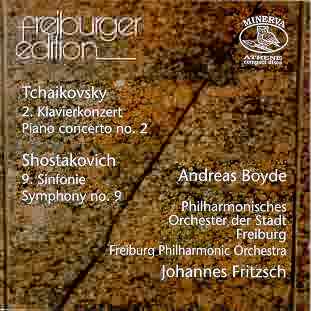
Tchaikovsky has often been described as the composer of grand light music. When I first heard this concerto forty years ago I was taken by the slow movement, where there are extended passages for a piano trio, and it reminded me of the Palm Court Orchestra and Max Jaffa. To my mind, Tchaikovsky's finest works are not the ballets or the works with 'good tunes' but the operas, chamber music and particularly his exquisite songs. He did not write well for the piano (see my interview with Peter Katin) and it is a curious thing that his most popular works are not his best works. He was, however, very fluent resulting in his music sounding very 'natural'; but he was also a superb technician particularly in remote keys e.g. the Piano Concerto No 1 is in Bb minor and the mellow Quartet no 3 is in Eb minor.
The First Piano Concerto is structurally an enigma. It begins with four minutes of that 'big tune' which is never heard again. The Second Piano Concerto is more coherent and logical and demands a pianist of exceptional skill, virtuosity and warmth. But it is not just the right notes and tempo but an understanding of this unfolding drama. Boyde makes detail come to life; he has an amazing capacity to build up long piano solos thereby making them full of interest. His cadenzas are breathtaking and the clarity of his finger work is stunning. And, thankfully, he is not a barnstorming, glamorous, athletic performer, although he generates tremendous excitement. He has enviable lyrical gifts and I have to say that, bearing in mind that this is a public performance (where one does not get a 'second chance'), it is very impressive indeed. The orchestra and conductor must also be congratulated.
The slow movement can wallow into cheap sentimentality if a strict tempo is not observed. I once read a review that stated that Tchaikovsky was inspired to write this movement after hearing the slow movement of Brahms' cherished Double Concerto. Tchaikovsky wrote his work in 1880, Brahms in 1887! In this movement Boyde and Fritzch combine effectively to prevent the music deteriorating into cheap Johann Strauss confectionary. While the performers avoid these pitfalls they also capture the warm mellowness. We have music, not an indulgence in mawkishness. There are, however, moments of tender beauty and the pianists clever timing of his entries enhances the music's expectations.
The finale Allegro con fuoco is a brilliant tour de force. Many pianists who refuse to play this concerto stating that they do not like it, are hiding the truth that they cannot play it. And this is one reason why the work stayed on the shelf for a long time. I would have preferred a stronger attack in this movement but this is more than adequately compensated for by the sparkling clearness. Then, all of a sudden, the performance explodes - a marvellous moment - and the work rushes on to an exhilarating and ruthless conclusion.
I hope Boyde may consider performing Tchaikovsky's other fine piano and orchestra work, the Concert Fantasy of 1884 also in G major. Peter Katin's unrivalled performance with Boult is still available, fortunately.
Shostakovich Symphony No 9 is sometimes maligned for being 'lightweight' but as with the unsurpassed finale of his Symphony No 6, of which Fritz Reiner's version is, by far, still the best, Shostakovich introduces a burlesque sense of humour probably to counteract the repressive Stalin regime.
I was brought up on Mravinsky's performance and so, rightly or wrongly, I judge all performances by that. Perhaps Fritzch's performance may occasionally lack some finesse but when one considers the amazing detail he reveals and his excellent control and balance this seems insignificant. There are some superlative woodwind solos and the intonation throughout is remarkably secure but I found the tempi rather cautious.
The exemplary recording greatly aids the clarity of detail.
Reviewer
David Wright
Performances (concerto)
(Shostakovich)
Recording 
See previous review of this disc by Rob Barnett
VERDI and Variations Giuseppe VERDI (1813-1901) String Quartet - arr for strings by Yuli Turovsky Marc-Olivier DUPIN (b. 1954) Fantasia on Arias from La Traviata Antonio Pasculli (1842-1924) Grand Concerto on Themes from Verdi's I vespri siciliani Philippe Magnan (oboe); Alexander Trostiansky (violin) I Musici De Montréal conducted by Yuli Turovsky
CHANDOS CHAN 9662 [56:46]
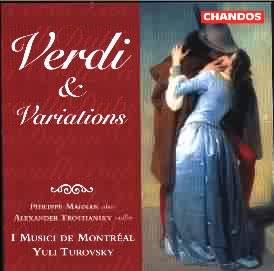
Verdi wrote only one piece of chamber music - his string quartet written in Naples in spare moments when the production of his Aida was delayed. Its first performance was greeted by one critic as a masterpiece. Verdi, always the realist commented, "I don't know whether it's beautiful or ugly. I only know that it is a quartet." It was written as an exercise in commanding this musical form without any literary or dramatic associations. Having said that, there is a hint of Falstaff's fairy tormentors in the fugal finale, and there is something of Amneris's music in Aida about the opening Allegro. The Andantino, marked 'con elegenza' is really a rather coy-sounding intermezzo. The brilliant scherzo has a lovely lyrical cantabile melody. The conductor on this album, Yuli Turovsky has made a convincing and sympathetic transcription of the quartet for strings adding colour and weight and the work is played with panache by I Musici.
Marc-Olivier Dupin maybe a young modern composer but his thoroughly enjoyable Fantasia on Arias from La Traviata is cast in the full-blooded late Romantic idiom. If you know and enjoy Franz Waxman's Carmen Fantasia you will know what to expect. Verdi's well-loved melodies from his popular opera are transposed into a virtuoso showpiece for the violinist soloist - and Alexander Trostiansky grasps every opportunity. Hugely enjoyable.
Antonio Pasculli's Grand Concerto on Themes from Verdi's I vespri siciliani is another virtuoso showpiece - this time for oboe. One of the great oboe virtuosos of the second half of the nineteenth century, Pasculli's compositions showed off his considerable technique. Philippe Magnan makes his instrument sing most eloquently and throws off the more difficult florid passages of the work with seemingly effortless ease.
A most interesting and rewarding album
Reviewer
Ian Lace

Stokowski's WAGNER Die Walküre: Wotan's Farewell and Magic Fire Music Tristan and Isolde: Symphonic Synthesis Parsifal: Symphonic Synthesis from Act III Matthias Bamert conducts the BBC Philharmonic
CHANDOS CHAN 9686 [63:48]

A commentator once said of Wagner: "there are some glorious five minutes but also some tedious half hours" - a view I can testify having more than once, in my student years (too long ago), standing at the back of the stalls at Covent Garden through performances of The Ring. Stokowski's tone poems, after Wagner, are an ideal solution for those who prefer those glorious five minutes; and for those who prefer orchestral music. (They know not what they are missing!)
In his early recordings of music from Wagner's operas, he occasionally used Lawrence Tibbett (look out for a review of the new biography of this tempestuous American singer on this site soon). Tibbett sang in Wotan's Farewell and Magic Fire Music for a set of 78s made in 1934. The alternative purely orchestral version is heardon this album. Wotan has punished his favourite daughter for protecting the illicit romance between brother and sister, Siegmund and Sieglinde. Wotan threatens to put Brünnhilde into a deep sleep but she pleads with him to encircle her with a ring of fire that only a hero can penetrate. Bamert does Loge's (the God of Fire) work very well in creating the flames that lick angrily around and rise above Brünnhilde as she lies waiting her release by her hero Siegfried who here sounds as lumbering as he is beefy.
Listeners are warned that listening is best experienced with headphones. The cavernous acoustic of New Broadcasting House seems to soak up the sound so that one has to turn up the sound levels only to be blasted out of one's seat by the occasional huge dynamic.
The Tristan and Isolde Symphonic Synthesis is a considerable work of nearly 32 minutes duration. After the Prelude closes, Stokoswki has incorporated an extended selection of music from all three acts including the 'Liebesnacht' (Night of Love) from Act II and the passage in Act III where the dying Tristan sings of his longing for Isolde. The Synthesis closes with, of course, the Liebestod. Stokowski was a master of string sound and he allocates much of the vocal material to the cello section and to the violins, thus making the sonorities even more voluptuous especially when the strings follow his request for 'free-bowing' as the BBC Philharmonic players do here. Now I worry that familiarity with this music, especially the Liebestod has affected my critical faculties but even after listening to this CD two or three times I feel that this performance should have left me more shaken and stirred. It sounds powerful enough but the passion does not grip me as much as I think it should.
Bamert's Parsifal music fares better It is impressive and moving enough but stops just short of provoking those shivers. For his synthesis, Stokowski drew music from Act III of Wagner's opera embracing the action where Parsifal finds the land of the Holy Grail and includes the Transformation Scene with its tolling bells and procession of knights sounding quite magnificent.
An enterprising programme but sometimes too careful, and tepid.
Reviewer
Ian Lace
tar.gif)
VAUGHAN WILLIAMS: Symphonies Nos. 5 & 9 Bournemouth Symphony Orchestra. Kees Bakels
Naxos 8.550738 68m DDD
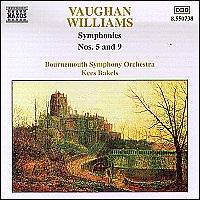
I have always considered the Fifth as Vaughan Williams greatest symphony, in fact the unique combination of powerful musical motifs combined with a rapt and deep serenity is equaled to my mind only in Elgar's even nobler Second Symphony. I had eagerly awaited this next Bakels' release with anticipation after his thrilling and outstanding account of the Seventh Symphony, but must say that I am sorely disappointed by a reading that remains slightly cold and unbalanced to compare with the very best. Bakels and his admirable Bournemouth band come into obvious comparison with a host of homegrown products but I will select Handley and Boult (1953) for sake of outstanding pedigree to be found in both records. The mysticism and permeating holiness that combines most of the Preludio is well caught in Bournemouth although Vernon Handley is just a bit more convincing in his pacing. Bakels lingers and speeds up in gear-change fashion, definitely not a recommended tool in interpreting this magnificent movement. Conversely the Scherzo is fleet and enjoyable with a swiftish tempo set and the angels flying about in merry congregation. However, it is obvious that an inspired Romanza is the kernel of this particular RVW work. Bakels is adequate although the scared music never lifts off the ground in the way Boult's classic 1953 Decca account does (reissued on Belart), but it would be obviously unfair on the Dutchman to expect such astonishing inspiration! To my mind this Naxos release disappoints in the Finale where a combination of fast tempi and disjointed structural moves generally contribute to a cold shower reading which is definitely not in the class of Handley's superbly concentrated LPO account that really wins hands down as a modern version. So not an ideal version of the Fifth! Kees Bakels tends to perform better in the later RVW works (his outstanding Eighth was a case in point) and it is good to have this superb account of the Ninth in the catalogue. The composer was obviously rather concerned with thoughts on the afterlife when writing this work and this mysticism shows in the grandeur and awesome instrumentation of the movements. The Moderato maestoso is finely done and there are some superb interpretative points to be heard in the closing pages of the score. The same goes for the universe-like solemnity of the Andante sostenuto with the BSO strings reaching rapturous heights of inspiration throughout. The mystic Andante tranquillo is also marvellously steered, indeed I would compare it to Handley's similarly awe-inspiring EMI account except Bakels has the better engineering for those final notes that seem to come from outer space. We have become used to Naxos' outstanding notes for this series and this release is no exception as is the wide dynamic range afforded to the music. I'm afraid I cannot recommend Bakels' Fifth as a first-choice but the cheap price prompts me to urge all seasoned RVW enthusiasts to purchase this addenda to their discography for the sake of the fine Ninth which is on offer.
Reviewer
Gerald Fenech
Performance: (No5/No9) /
Sound:
Sir William WALTON Hamlet. As You Like It Michael Sheen (Narrator) RTÉ Concert Orchestra conducted by Andrew Penny
NAXOS 8.553344 [52:43]
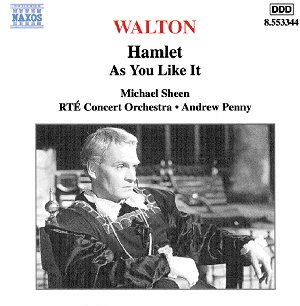
William Walton and Laurence Olivier first met in 1936 when Olivier co-starred in Paul Czinner's production of As You Like It with Elizabeth Bergner, Czinner's wife. In 1943 Olivier decided to put his Henry V on film and approached Walton to write the music. This was the first of three films on which Walton and Olivier collaborated together; the others were Hamlet, written in 1947 and released in 1948, and Richard III in 1955. The association was a happy one and Olivier said of Walton's music. 'I have always said that if it was not for the music, Henry V would not have been the success it was.'
Hamlet contained about fifty minutes of music from which Muir Mathieson, musical director of the film and a long-standing friend of the composer, edited two concert works: an orchestral poem called "Hamlet and Ophelia", and the "Funeral March", containing music from the opening and closing titles. Malcolm Sargent also collected and arranged isolated fanfares into a piece entitled Fanfare for a Great Occasion. In her book William Walton, Behind the Façade Susana, Lady Walton, lists the score of Hamlet (with a few exceptions) as one of Walton's missing scores. Nevertheless, the late Christopher Palmer, who served Walton so well as an arranger, has given us a forty-minute work entitled Hamlet (A Shakespeare Scenario in Nine Movements for Large Orchestra). These movements are 'Prelude;' 'Fanfare and Soliloquy,' in which Michael Sheen ably recreates the 'O! that this too too solid flesh would melt.' soliloquy; 'The Ghost;' 'Hamlet and Ophelia;' 'The Question,' which incorporates 'To be or not to be;' again spoken by Michael Sheen; 'The Mousetrap;' 'The Players-Entry of the Court;' 'The Play;' 'Ophelia's Death;' 'Retribution and Threnody;' and 'Finale (Funeral March)'. Some have called this music 'even finer than its predecessor, especially in the delicate use of motifs such as the poignant theme associated with Ophelia' (Gilliam Widdicombe, 1984, sleeve notes to the EMI LP entitled William Walton, Music for Shakespeare Films). I cannot agree, considering Henry V to be one of the finest of all film scores, but am profoundly grateful to have this music to add to the Walton discography.
All of the music in Hamlet displays the tragic nature of Shakespeare's play. 'The Ghost' is highly effective and eerie, as Hamlet becomes more agitated and bent on revenge, and the final moments of the Queen's retelling of Ophelia's death are decidedly poignant. The suite concludes with a threnody to those who have died and the 'Finale'-a dead march which incorporates elements of the opening Prelude.
The surprise on this CD was the suite from As You Like It, the second of four films Walton scored for Paul Czinner. The five movements of Christopher Palmer's suite (subtitled A Poem for Orchestra after Shakespeare), arranged in 1989 and played without break, are 'Prelude,' 'Moonlight,' 'Under the Greenwood Tree,' 'The Fountain,' and 'The Wedding Procession.' Appropriately satirical and pastoral, suiting the mood of the play, this is charming music written shortly after the completion of Walton's monumental 1st symphony. The French horn is effectively used in 'Moonlight,' which features exquisite use of key changes to suggest shifting light textures against a nocturnal background. Under the Greenwood Tree, omitted from the film, is restored here as the third movement sung by an unnamed soprano. 'The Fountain' depicts a delicate fountain, growing livelier, leading to the final 'Wedding Procession,' the sort of music at which Walton excels, as he was later to show in the 'Crown Imperial' and 'Orb and Sceptre' marches and such works as 'The Johannesburg Festival Overture.' This is splendid and unexpected Walton-a real find.
Andrew Penny and the RTÉ (Radio Telefís Éireann) Concert Orchestra give a good accounting on this fine CD. My only quibble would be the soprano in 'Under the Greenwood Tree,' whose voice was perhaps not quite up to the quality of the orchestral accompaniment and why I awarded four-and-a-half stars instead of five.
Reviewer
Jane Erb
tar.gif)
ALBERTO WILLIAMS (1862-1952) Symphony No. 7 in D major Op. 103 Eterno Reposo (1937) 38:48 Poema del Iguazu Op. 115 (1943) 35:11 Orquesta Filarmonica de Gran Canaria/Adrian Leaper
recorded 10-13 June 1996 Gran Canaria ARTE NOVA Classics 74321 43329 2 [74:08]
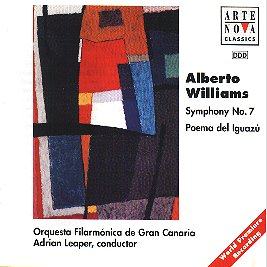
These are world premiere recordings of works by a composer whose name I knew of but whose music was, until now, a complete unknown. Williams was known to me from a reference in a battered copy of Slonimsky’s 1940s book on South American composers.
The notes for this valuable CD are rather sketchy but they do provide some detail. They point out that Williams, a native of Buenos Aires, wrote music falling into three phases: 1862-1890 reflecting the strong influence of European models; 1890-1910: an approach to more nationalistic language. 1910-1952 back to more cosmopolitan models. The works on this disc fall into the last period and are provocative for their musical language in a time of world conflict. Perhaps some of that sorrow and tragedy appears in the flanking outer movements of the symphony.
The Seventh Symphony, like its disc-mate, is in four movements. The middle two are dance-lead, betraying the influence of the ballet. The outer movements are more apocalyptic. The first is clearly striving for great things. The language has something of Scriabin and even more of Miaskovsky. Its quietly chanting music in La Piramide seems to suggest an enigmatic smile. The next is a fantasy dance movement making quite a relaxation after the first. The spirit is of a grand age ball in a sophisticated Edwardian hotel. At 3:50 comes a clearly delineated rhythmic theme of Baxian (Symphony No. 5) accent. By contrast, next follows a solo violin serenade in which concert master Anatoli Romanov takes up the chattering Baxian theme and spins it into a counterpart of Vaughan Williams’ Concerto Academico. The breezily vigorous Joueuses De Crotales (a crotal is a rattle or small spherical bell) is in much the same spirit as the second movement. The finale gives the symphony its title. Whether Williams had eternity in mind I do not know. It has some of the enigmatic dreaminess of the first movement. Chant-like, the theme conjures up the image of some great pagan cathedral. The mood is not too far away from Janis Ivanovs’ impressionistic Atlantis symphony no. 4. It is also the longest movement at 13:27. This music tells tales of a world where cold saps the warmth. The spell of these notes testifies to a composer of concentrated inwardness, of mood and of imagination. This concentration is interrupted at 8:33 by a disruptive brass intervention which impacts like a comet-strike on this chaste but vaguely threatening world. Then a gust of wind blows the curtains followed by another militaristic miniature fanfare at 9:35. A stern resolute theme emerges with a remorselessly marching tread. The symphony ends in jubilant uproar. Some of these mood-shifts are unnervingly jarring but the moods themselves are quite captivating.
The Poema del Iguazu is a picture-suite of the river Iguazu. The first movement is Las selvas dialogan con las cataratas (The forest converses with the waterfalls). The movement is low key; rather light-spirited with snatches of Beethoven, D’Indy and Tchaikovsky. It is propelled along by a patterned rhythmic theme of cheery Brahmsian/Straussian character. The regally flowing Barcarola sounds decidedly French. It offers a superb long-breathed tune. Here the strings sound less than luxuriant but, my, what a lovely theme. Next comes La Luna Ilumina Las Cascadas - a Nocturno. This has an impressionistic magical feeling paralleling the enigmatics of the first and last movements of the symphony. The shades and colours are very gentle - pastel darks and shades. I wonder if his apparently famous Rancho Abandonado sounds like this. The finale depicts a great waterfall (The Devils Throat) with vigorous panache. The mood is hunting and chivalric (like an Argentinian Froissart) with a full bow in the direction of Tchaikovsky’s Symphony No. 4.
According to the notes Williams has nine symphonies to his name. His second dates from 1910. I would like to hear more please. Does anyone have tapes of these?
Good to see Adrian Leaper figuring so strongly in the Arte Nova lists. He is well known to me from his BBC Radio Three broadcasts. His repertoire in broadcast is quite breathtaking: Arnell Symphony 6, Holbrooke Ulalume, Bridge, Krein (symphony 1), Leigh, Moeran, Somervell’s Thalassa Symphony, Veale and Lauricella.
This is an excellently filled disc. The music is never less than interesting and often more than that. It is definitely worth the very small investment. I have not seen any reviews of the disc; such is the focus of the magazines on the great and the good. No doubt Fanfare have covered it?
The notes, which could with advantage have been longer, are in German, French and English.
Reviewer
Rob Barnett
tar.gif)
LORA DIMITROVA. Piano Works. BACH, Partita No 4 in D minor BWV 828; BARTÓK, Six Dances in Bulgarian Rhythm (Mikrokosmos); SCHUMANN, Symphonic Studies Op 13. Lora Dimitrova (piano)
ESL 199801 [70' 44"]. Available from Annon Music Services, 44 Cromwell Road, Canterbury, Kent, CT1 3LE. Tel. +44 (0)1227 463867
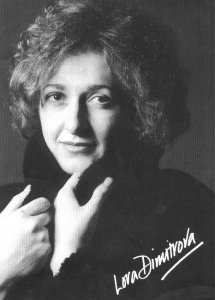
No less a person than Sir Georg Solti said, "Lora is an outstanding pianist and an exceptionally fine musician." The distinguished composer Francis Routh was grateful to me for my introducing Lora to and he composed his Scenes for Piano IV, 'Bretagne', Op 68 for her. And this Bulgarian pianist is keen to perform British works; she told me that a performance of James Brown's Piano Sonata would have the same effect as Horowitz premiering the Barber Sonata; she is keen to play the Searle Sonata which she describes as 'stunningly original and astonishing'. When I heard her performance of Bartók's Piano Concerto No 3 and, later, Beethoven's Sonata in C minor Op 111, I was amazed at her insight into these works. Her skill and technique are irreproachable.
I was thrilled at her approach to the Bach; the opening movement especially was very tender. She does not play Bach with all those stylish quirks that are profoundly irritating such as almost grinding to a halt at cadential climaxes or at the end of a movement, or those emphasised trills and other ornaments. Here are performances that have a continuity and a clarity and, quite frankly, everyone should play Bach like this. When she plays chords each and every note is clear and they are not announced in a baroque style. The absence of the hindrances and impediments of 'style' lifts this music out of the mundane and into something truly delightful. Every note is placed with care. It is a beautiful performance and her tone is simply perfect. I repeat, everyone should play Bach like this.
The Bartók requires pianistic skills not required in baroque or classical repertoire. Maintaining demanding rhythms can be a serious pitfall but not so here. The sign of a truly great pianist is when the difficulties do not show. They don't here.
The Schumann is the most important work on the disc. The Thirteen Symphonic Studies are implemented by the additional five posthumous variations which Brahms rescued after Schumann's death. The work began as a theme and variations and seemed to depict Schumann's romance with Ernestine von Fricken. That the theme is a kind of funeral march may tell us about this romance or Schumann's depression at his foreknowledge of its eventual demise. Whatever may be the case, it is a fine work and avoids being a set of miniatures which some believe his Carnival Op 9 to be. The later work comes across as a whole.
Lora's reading is very secure; it is never ordinary but full of variety, colour and understanding. It is not just the notes that are known but the music itself. Lora brings out the beauty and elegance of the work and there is much to admire. Some of the music does tend to ramble and be too introspective and one may not always be in the mood for what may be Schumann's heart-searching.
But this performance takes us to the soul of Schumann and I know no pianist would ever do this before with this deeply felt score.
The recording is very clear although I would have preferred a little more bass ... but that is a minor point in a recital that has given a very rewarding personal experience.
Reviewer
David Wright
Performances

Recording

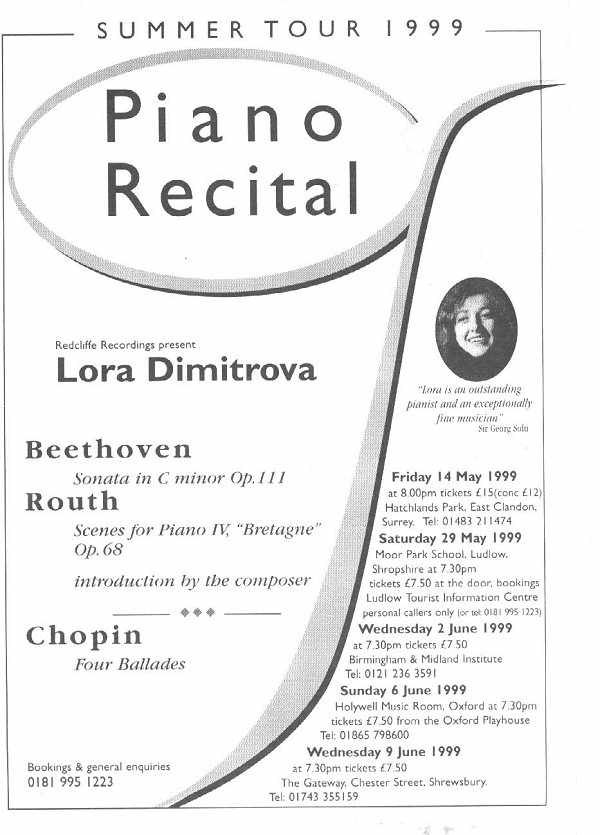
You’d be SURPRISED
Barbara Kennedy with Peter Lockwood (piano)
GLOBE GLO 6045 [55:03]
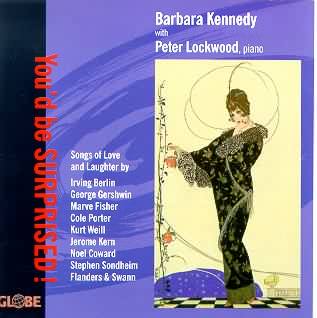
Songs of Love and Laughter by Irving Berlin; George Gershwin; Marve Fisher; Cole Porter; Kurt Weill, Jerome Kern; Noel Coward; Stephen Sondheim; and Flanders and Swann.
This is a delicious treat of often naughty songs sung with great sly, coy wit by Barbara Kennedy, an experienced opera and operetta singer. How seductively she sings, "…I love to run my fingers over the keys" and "…Oh! Oh! I love an upright…" in the opening number - Irving Berlin’s I love a piano. Then she complains in Cole Porter’s The Physician that – "…he looked after my physical condition and his bedside manner was great…he said my bronchial tubes were entrancing…but he never said he loved me!" Returning to Irving Berlin we have the title song, You’d Be Surprised in which we learn that although Johnny is bashful "…when you get him alone…you can’t judge a book by its cover… You’d be Surprised!".
George and Ira Gershwin’s My Cousin in Milwaukee had boy friends by the dozen and "…when she sings hot, you can’t be solemn, it sends shivers up and down your spinal column..." Barbara then assures that she is Just an old-fashioned girl in Marve Fisher’s song but she dreams of being supported by an old fashioned millionaire. Let Me Sing and I’m Happy she then pleads to Irving Berlin’s music. Kurt Weill’s The Saga of Jenny tells of headstrong Jenny who leaves a trail of devastation behind her as she advances through life – "Jenny made her mind up at twenty-two that to get a husband was the thing to do… she got herself a husband but it wasn’t hers…" Jerome Kern is represented by his sentimental, Bill.
Two numbers from Cole Porter’s Kiss Me Kate are included: So in Love sung and played with heavy irony and I hate Men - "… In our democracy I hate the most the athlete with his manner bold and brassy, he may have hairs upon his chest, but, sisters, so has Lassie!" Porter’s My Heart Belongs To Daddy has Kennedy getting her comfortable priorities right. Flanders and Swann’s A Word in My Ear ("…I’m lauded, applauded, recorded but they seem to have missed that I’m Tone Death") is a brilliantly funny take-off of musical mannerisms. Noel Coward says We must all be very kind to Auntie Jessie for she has never been a mother or a wife. Stephen Sondheim is represented by two numbers. Losing My Mind is a song about loneliness and unrequited love sung by Kennedy with understated yet affecting poignancy. I Never Do Anything Twice is another comic pearl - "… no matter how nice, I never do anything twice…once, yes, once is delicious; but twice would be vicious or merely repetitious."
Bloody marvellous
Reviewer
Ian Lace
tar.gif)

BOOK REVIEW: WALDER, David E. How to Stay Awake During Anybody's Slow Movement (The Average Music Lover's Guide to Concert-going). Published by Sound and Vision ISBN 920151-20-5
This is a light-hearted little book written by an author whose musical qualifications far outrank his humour which is decidedly juvenile.
However, if you can tolerate( or preferably skip) the endless introductory blurb and realise that the plethora of names frequently referred to is totally irrelevant, the book may improve as it gets into the swing of things.
The humour is generally vulgar, less than adult which may render it inoffensive. It can be quite funny. The adult has a good eye for the ridiculous and uses this in quite an amusing way to lampoon concert audiences. Albeit fairly well hidden, the book contains some useful information for the newcomer to music although if such a newcomer is an earnest seeker after knowledge I doubt if this is the book he would choose.
The book can be best recommended as an accompaniment to a tedious and delay-ridden journey by public transport because it does raise several smiles and even the odd snigger.
And, incidentally, real music-lovers would not sleep in a slow movement!
Reviewer
Gill Goodwin.
Would you care to say something? The thirty year story of a successful music society by N K Scott CBE, Overleigh Press, Overleigh House, East Cliff, Preston PR1 3JE England. pub. 1998 ISBN 0 95341560 0 £25 plus £5.00 postage
Oh lucky, lucky Preston!This book records one man's vision, supported by enlightened corporate sponsorship. As I am sure Bill Bryson would concur, it is one of the endearing facets of British life that here can flourish such an incredible variety of hobby clubs, societies and affiliations, many because of the spirit of enterprise and unstinting self-sacrifice of one or two individuals, often meeting in the most unprepossessing surrounding - dingy church halls or back rooms of institutes usually on uncomfortable plastic stacking chairs. Each one adds to a rich cultural heritage and serves as an important focus to the social life of its members. I t was this spirit that used to inspire Gustav Holst to trek across hedgerows and fields in order to conduct the Bourton-on-the-Water Choral Society (now long gone, along with the railway branch-line and halt). In spite of the immense social changes over the last 100 years it is remarkable that so many still survive, even if in declining numbers. There are still colliery brass bands even where the colliery no longer exists - there are more colliery brass bands than there are working pits.
In spite of declining government support and diminishing musical tuition in schools, one of the deciding factors in our loss of Sir Simon Rattle from Birmingham, there still flourish over 2000 music and recorded music societies as well as many choral societies, amateur orchestras and brass bands. Living in Coventry, I have the choice of three competing Jazz Festivals each summer, all within 20 miles of my house - and jazz is a decidedly minority interest (or is it? Rumour has it that Jazz now outsells Classical CDs). However few organizations can show the 30 year success story of the Building Design Partnership (BDP) Music Society.
Here we find a blue-print for the running of a successful society.
The idea for the music society was Keith Scott's. Having just graduated as an architect from MIT Boston, he was in the Arizona desert to meet Frank Lloyd Wright who had been one of his tutors. Frank spent his winters just south of the Grand Canyon. In his house he had a large room with a stepped floor where he used to invite artists to stay for the weekend and put on cultural entertainment, there being nothing else available in the desert.
When Keith Scott joined the Building Design Partnership in Preston, Lancashire, he found himself in another cultural desert. However, a few miles away in Whitehaven lived the fabric designer, Sir Nicholas Sekers who, having a similar idea to Wright's, had transformed a derelict barn into a replica Venetian Palace and invited some of the world's star performers to play there; Brendle, Richter, Schwartzkopf. He found this a valuable marketing tool in attracting and maintaining clients and. more importantly, in retaining his own talented staff.
The Building Design Partnership was a real partnership with the staff putting up the money for the development of their own premises. The staff had grown from 35 when Keith Scott joined in 1958 to around 400 a decade later and those early experiences coalesced into the idea of providing artistic stimulation for the staff in an attractive setting that would enable them to invite top artists. So a Music Society and an Arts Society were born and a 1901 Steinway purchased and an old burnt-out bowling alley refurbished as an art gallery and concert hall. The BDP partners offered a guarantee to cover artist's costs. There was also a buffet area so that both society members and artists could eat, mingle and chat after the performance - which Scott stresses as highly important. Through a willing band of helpers food was provided at cost.
This book presents a 30 year success story, is beautifully illustrated with contemporary photographs of the artists taken (mainly) by Roger Park, a nationally acclaimed architectural photographer (the caption of one of which has been reversed when naming the artists). "Would you care to say something?" was the invitation extended to all artists and, in the intimate atmosphere of the gallery, added a bonus to the performance. However, not all artists, including Jill Gomez, were prepared to say something!
The first recital was by Colin Horsley in January 1969 (who later returned to mark the 10th anniversary). In two further recitals that year Léon Goossens with John Wilson on piano and later Sheila Armstrong with Martin Jones were to perform. What is amazing are the fees they were paid - £260 in total. To put that into perspective I was paid £1800 pa at that time as a University lecturer. The society subscription stood at £1. Even today they find it possible to engage "about to become" world-class artists for £1000 - although for a Pollini or Brendel it would be ten times that! The subscription has risen to £75 - about £8 per event including the wine and buffet -gulp! All the concerts are detailed in the appendix and each bears some discussion in the main text. It is a panoply of artists of international stature and it is the anecdotes that make this book such a compelling read. Sir John Manduell, then Head of Music at Lancaster University ( and who provided a foreword), suggested that University students should provide a concert, and this became an annual event. The second season had 8 concert and most seasons from then on had between 8 and 10.
In 1970 they were able to purchase the Whitehaven Steinway for £1000 (now valued at £25,000) and for a short while they had both pianos and were used by Cyril Smith and Phyllis Sellick. The earlier Steinway was eventually purchased by david Wild.
For a few years in the 70's the society also invited Jazz musicians but could not attract sufficient audiences to make it a viable proposition. There is seeming intolerance of other styles in Jazz aficionados but at least they tried. My own Society is even more intolerant of Jazz. The only other slight shadows on the Society's history was the local singer Amanda Roocroft, in an episode that reflects well on the music society and very badly upon her. This is not the place for details - you will have to buy the book for those. The other shadow was cast by Yuri Bashmet who failed to appear three times in a row.
I cannot resist one or two anecdotes:
Alfred Brendel to a young pianist who made grunting noises as he played: "We must never make noises when we play - I make horrible faces but nobody can hear them".
A military man who asked Gerald Moore "Mr Moore, have you ever in the course of your long and distinguished career given any thought to the idea of becoming a pianist?"
Alfred Brendel again, outdoing Keith Scott in his knowledge of Bavarian Rococo churches - of which Keith had made a personal study!
Anthony Hopkins's party piece of sitting with his back to the piano and playing it with his hands behind him
Sidney harrison on pianists who affect an elaborate swooning of the body and windmill sweep of the arms before the fingers actually touched the keyboard: "Always remember the piano couldn't care less".
Alfredo Campoli suffering a sever attack of cramp in Saint-Saëns Havanaise
Richter judging a piano competition with all categories judged on a scale of 0 - 20. All his marks were either 0 or 20."Well to me it's quite simple. They can either play or they can't".
In 1994 BDP moved out of Preston but the University bought the premises and carries on the tradition.By 1996 the membership has risen again to match that before BDP and its staff departed.
So here's to the next thirty years!
Reviewer
Len Mullenger
BOOK REVIEW: The Proms & Natural Justice Robert Simpson Published by Toccata Press 40 Floral Street London WC2 £1.95 ISBN 0 907689 00 0
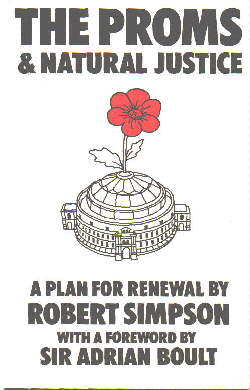
This little book was published 19 years ago, a year after Dr Simpson relinquished his position on the BBC's Music staff. In this important and provocative book Robert Simpson, for nearly thirty years a BBC Music Producer scrutinised the methods by which the Proms were planned. This late in the day, it is to a major extent taken over by events. Nevertheless, Simpson's thesis is still relevant, despite the enormous changes that have taken place within that (still) angst-ridden bureaucratic organisation. At the time, the BBC allowed the Controller, Music the absolute right to decide Prom programmes until death or retirement. Since it was largely a management appointment, with succession virtually based on seniority rather than by musical qualification, the succession of the imaginative William Glock by a non-musician clearly rankled and brought Simpson's arguments to a head. Always ready to express robust opinions, but usually based on careful reasoning and his long experience inside the BBC, he argued that whoever the Controller might be, the effects of his individuality are bound to colour the programmes over time. He highlights in a convincing manner, the omission of many important composers. He felt the only logical way to give the Proms the flair that a single imagination can provide without the otherwise inevitable long-term imbalances affecting both composers and performers would be to appoint a separate planner of the Proms with a limited tenure of four or five years. Dr Simpson further examines the artistic gains and financial savings to be made from more extensive use of the BBC's own orchestras. Not only would this produce a saving of a staggering 62 % on costs at that time, it would give the planner almost total control over the repertoire. This would enable the Proms to become more adventurous than ever before and a true realisation of Sir Henry Wood's original vision.
Well, nothing changes. Due to his poor health in his final years, I never had the courage to ask my old friend whilst visiting him, what he felt about the appointment of a music critic to this important post, again without any clear indication of the length of the tenure. The same appointee now has sole control over the planning of the Proms. At least, it is no longer automatically a choice based on seniority within the management structure. That as much has been achieved. So we have to ask ourselves, does this book have any bearing on what has passed in the intervening years? One of his arguments was for the far greater use of the BBC house orchestras. The inevitable consequence would be that whilst it might save money, this major festival would have far less an international flavour with the present international visitors omitted. Does one man as planner now leave out, any composers because of the individual bias? And does he consult his music-trained colleagues for ideas and suggestions? This was another of Dr Simpson's objections at the time of his book, one he expressed forcibly once to me when visiting my Society. The book is interesting, albeit somewhat out of date. But at a modest £1.95, a fascinating insight into the BBC politics of the time by someone, not only a fine writer, but who became one of the most distinguished symphonic composers of our time. And, like I said…I don't think much has altered within the BBC.(photo: Robert Simpson with Horenstein at the Unicorn recording of his Third symphony: courtesy of Reg Williamson)
Reviewer
Reg Williamson
BOOK REVIEW: Whom the Gods Love - the life and music of George Butterworth by Michael Barlow Published by Toccata Press ISBN 0 907689 42 6 £25.00
This is a book that, for obvious personal reasons, I have been wanting to read for many years; That it has not been possible to do so until now is simply that it is only recently that an obviously devoted and resourceful author has come forward to fill this tantalising gap in the general history of English music. It has often been something of a burden, to be an English composer in the latter part of this Twentieth century, whose name has almost always been overshadowed by and frequently confused with that of his far greater namesake: the subject of this splendid book. There was however, an occasion when this writer sought lessons from Vaughan Williams who remarked:...."Your family name means much to me, for George Butterworth was one of the best friends of my youth, he was a very fine composer indeed," The family name then, must have stood me in good stead that day, for VW did briefly teach me and offer some of the soundest advice a young composer could ever have had.
Nonetheless, over the years many people have asked if in some way there is a connection with George Kaye Butterworth. This book hints at a possible answer. It lies, still as ever tantalisingly, on page 18 of Michael Barlows study, where the family pedigree is set out, but alas, inevitably leaves many question marks as to distant cousins and other relations. All that one has ever been able to deduce - from comments made in childhood - seems to be that there was some tenuous family connection with railways in the north of England, and that the Butterworth clan originates from Rochdale and its environs, where my own branch of the family come from. Musically, however, there is no evidence at all that any connection can be claimed. On the other hand, no younger composer of the English tradition can really claim not to have in some measure been influenced by the example of George Butterworth. As this book makes clear, his painstaking care in the surely oft-time laborious task of notating the very essence and character of English music is something those of us who go along with this tradition, must be greatly indebted to.
Mr Barlow's study displays something of the same meticulous care in the way so much hitherto unpublished material has been researched. He not only tells us things that most of us could not have known about Butterworth himself, but about a whole host of his contemporaries, so many of whom were lamentably of that lost generation between 1914 and 1918. There are details of the composer's early years, Eton and Oxford and comments from those, such as Sir Adrian Boult, who knew him well.
However, it is the account of Butterworth's enthusiastic involvement with English Folk Song and Dance, that is probably the most revealing. The handful of orchestral works are reasonably familiar to most British audiences, but few could have known how extensive Butterworth's practical interests were: his expertise in morris dancing and keeping alive what would have otherwise soon disappeared into musical oblivion. Mr Barlow analyses with great skill many of the features of folk song as collected and then eventually moulded by Butterworth into exquisite song, We are given insight into the way Vaughan Williams' "London Symphony" came about, and the especial influence Butterworth had on its gestation.
Finally, there is the account of Butterworths short but heroic military career, when a modest young man, one of the flower of his generation, was killed in a battle; a loss which has been felt in English music ever since.
Reviewer
Arthur Butterworth
MARIO LANZA - Tenor in Exile by Roland L. Bessette published by Amadeus Press. 270 pages $24:95 ISBN 1 57467 044 1
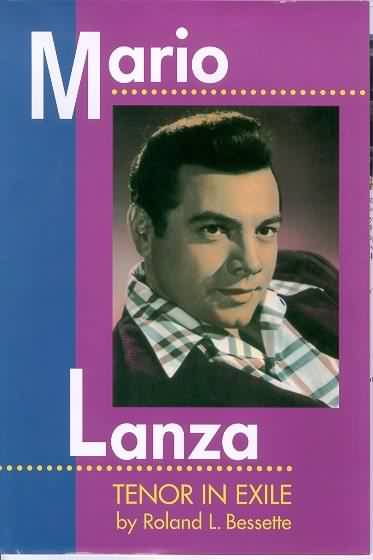
Mario Lanza died, at the tragically early age of thirty-eight, on Wednesday 7th October 1959. He had been hospitalised in Rome with phlebitis. A substantial piece of clot had broken away and lodged in his pulmonary artery. The death was listed as a heart attack. Several days later his body was flown home to America first to his home city of Philadelphia and then to Los Angeles.
His death was mourned by countless fans around the globe. Truly one of the greatest tenors of the century, his achievements are venerated by the Three Tenors: Pavarotti, Domingo and Carreras who have all praised his influence on their careers.
Yet Lanza was a controversial figure and Bessette does not shrink from sketching in the dark side of his turbulent life. Born in South Philadelphia of Italian parentage, he was undisciplined and self-indulgent, spoilt from the start by a doting mother. He learnt by emulation, listening over and over to gramophone records of opera stars; he never learnt to sight read. But the voice was prodigious enough, in tone, strength and range, to impress the notoriously demanding conductor Koussevitzky at the beginning of his career.
The book tells of Lanza's meteoric rise to stardom first in concert, then through radio, and recordings for RCA, through to films. His record royalties approached $1 million per year. His career in Hollywood peaked early with his third film The Great Caruso which turned out to be MGM's biggest money-maker for 1951 and one of its most profitable films of all time. Yet his rude, crude, boorish behaviour on-set antagonised too many people: he would get into fights, curse and shout at technicians, insult his leading ladies, and urinate anywhere that was handy including, on one occasion, a lagoon that had to be refreshed, etc. Property owners came to regret Lanza as a tenant because of his wrecking sprees. Ultimately all Hollywood studios were loathe to hire him and he was obliged to move to Italy where his last two films were made (he made only eight films). He was self indulgent in terms of food (his figure ballooned alarmingly and he was endlessly working out and dieting), alcohol and women. Bette Lanza, his wife, unable to cope with his seductions of countless women, the competition from his domineering mother and the pressures of a successful Hollywood career, sought solace in drink and drugs and continually berated Mario instead of supporting him. Lanza was basically insecure and subject to fits of intense depression and paranoia which, coupled with weight and drink problems, caused him to cancel many engagements and to funk appearances including a lucrative and crucial engagement at Las Vegas. All this behaviour Bessette puts down to the clinical condition, manic depression.
One wonders what further miracles of singing might have been achieved not only in the films (Lanza had a flair for comedy), records and in concert but also in opera had the talent been studied, directed, and disciplined but then the raw energy, sensuality and spontaneity might have been sacrificed? A compulsive, yet often harrowing read, the book includes a selected bibliography, a compact disc discography and a filmography.
Reviewer
Ian Lace
![]() COMPETITION WIN
a CD of your Choice from Crotchet
COMPETITION WIN
a CD of your Choice from Crotchet
![]()
 Search the Crotchet database from here
Search the Crotchet database from here
| Discs
on these pages are offered for sale. There is also a page of search
engines from a selection of on-line retailers
here.
Please support this web-site by buying your discs here. Disclaimer: Every effort is made to make sales links to the correct disc but, in the end, you must take responsibility for checking that what you are purchasing is what you want. Some of these discs were not actually available for sale at the time of posting but a link has been made in anticipation of their forthcoming availablility. |
Return to Index